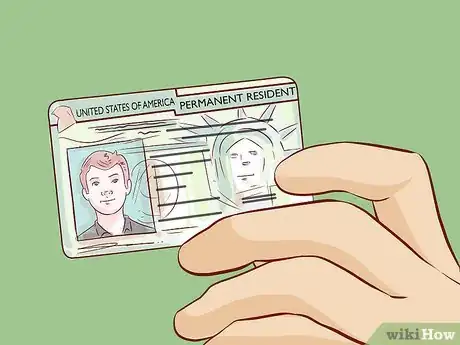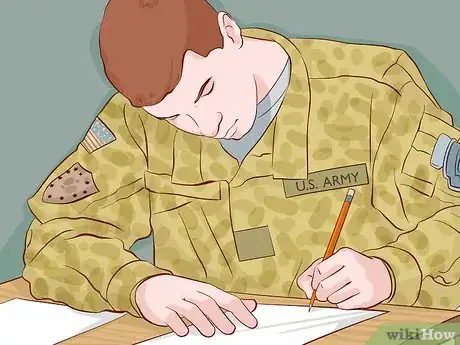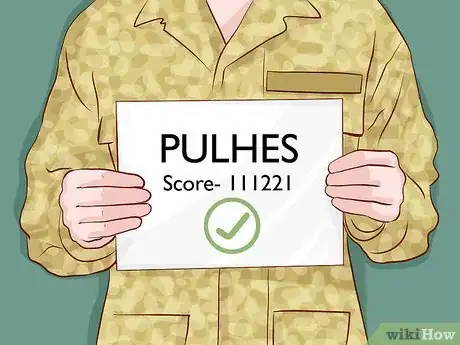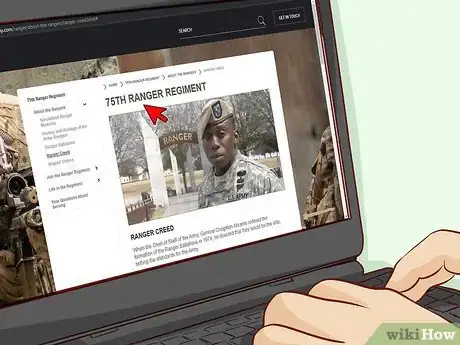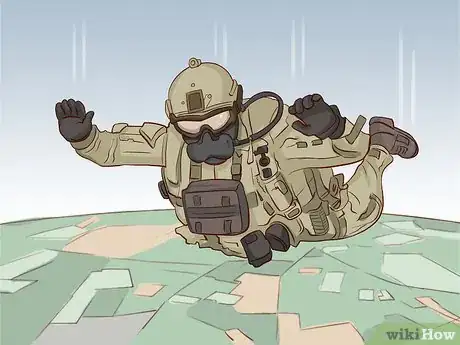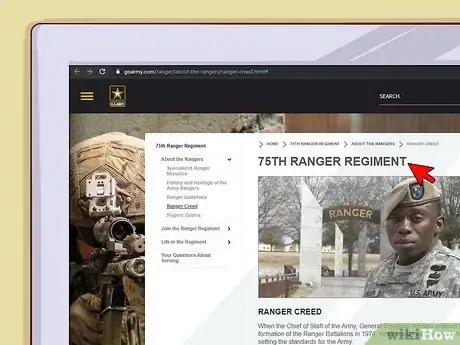This article was co-authored by wikiHow Staff. Our trained team of editors and researchers validate articles for accuracy and comprehensiveness. wikiHow's Content Management Team carefully monitors the work from our editorial staff to ensure that each article is backed by trusted research and meets our high quality standards.
There are 13 references cited in this article, which can be found at the bottom of the page.
This article has been viewed 16,407 times.
Learn more...
The Army Rangers are a highly skilled special operations unit within the United States Army that carry out military missions across the globe. To be an Army Ranger, you’ll first need to meet the basic qualifications and enlist in the U.S. Army. Once you become a soldier, you must go through various training schools, as well as the Ranger selection process, to gain the necessary skills and experience needed to perform Ranger duties.
Steps
Meeting the Basic Qualifications
-
1Be a citizen of the United States. In order to become an Army Ranger, you’ll need to be a citizen of the United States.[1] While you can join some branches of the United States military with a green card, green card holders are not eligible for the Ranger Regiment (also known as the 75th Regiment).
- As an Army Ranger, you’ll need to be able to obtain the minimum level of security clearance for Ranger duties. Without citizenship, you won’t be eligible for the level of Secret clearance required.[2]
-
2Serve in the United States Army and have active duty status. In order to qualify to volunteer for the Ranger Regiment, you must serve in the U.S. Army for at least 6 months. In addition, you must have active duty status to volunteer for the Ranger selection process.[3]
- Members of the National Guard, Active Guard Reserve, or Army Reserve do not qualify to volunteer for the Ranger Regiment.[4]
Advertisement -
3Receive a General Technical Score of 105 or higher. When you first enlist in the Army, one of the first things you’ll do is take the Armed Services Vocational Aptitude Battery (ASVAB) test, which is designed to help determine which Military Occupational Specialties (MOS) would be the best fit for you.[5] You’ll need to receive at least a 105 on the General Technical component of the test to be able to volunteer for the Ranger Regiment.
- This component of the enlistment test assesses your word knowledge, paragraph comprehension, and arithmetic reasoning skills.
-
4Obtain a PULHES of at least 111221 to prove your physical capability. If you want to volunteer for the Ranger Regiment, you’ll need to prove that you don’t have any physical or psychiatric obstacles that could prevent you from doing your duties. To do this, you must have at least a 111221 on the PULHES section of your soldier profile.[6]
- Each number in a PULHES score describes one of the components of the examination, which include physical capacity/stamina (P), upper extremities (U), lower extremities (L), hearing and ears (H), eyes (E), and psychiatric (S).
- For the U.S. Army in general, receiving a 1 or 2 means that a soldier can be deployed, while a score of a 3 or 4 in any category prohibits a soldier from being deployed.
- To be a Ranger, you’ll need to receive a 1 for your physical capacity/stamina, a 1 for upper extremity strength, a 1 for lower extremity strength, a 2 for your hearing ability, a 2 for your eyesight, and a 1 for your psychiatric evaluation.
-
5Avoid UCMJ or drug or alcohol related incidents for at least 24 months. In order to be able to volunteer for the Ranger Regiment, you’ll have to be a person in good standing according to Army standards. To be a person in good standing, you cannot have any pending Uniform Code of Military Justice (UCMJ) actions against you, or have had any drug or alcohol related incidents in the last 24 months.[7]
- The UCMJ is the military justice system that handles criminal offenses under military law. In general, if you act against military law, you’ll be court-martialed and face trial in a military court.[8]
-
6Attain the minimum security clearance for Ranger duties. Because Rangers are often involved in highly classified military operations, all potential Rangers must be able to attain the minimum level of Secret clearance required of all Army Rangers. In order to obtain clearance, you have to be a citizen of the United States, have a position that necessitates clearance, and pass a background check.[9]
- Depending on the level of clearance needed for your Ranger position, you may also need to undergo additional screening.
- How you’ll apply for security clearance will depend on what type of clearance you’ll need for the specific duties you’ll be performing as an Army Ranger.
Training to Become an Army Ranger
-
1Sign an Option 40 contract if it’s available during the enlistment process. An Option 40 contract is an enlistment option that will put you on the track to train to join the Rangers. While there are other ways that you can become a Ranger, having an Option 40 contract is the only guaranteed route that initiates your training right when you enlist.[10]
- There are a limited amount of Option 40 contracts available each year, and spots tend to fill up quickly.
- If you don’t receive an Option 40 contract during the enlistment process, you can attempt to volunteer to become a Ranger during Basic Combat Training, Advanced Individual Training, or while attending Airborne School.[11]
-
2Complete the Army’s Basic Combat Training. Also known as boot camp, Basic Combat Training is a training process required of all Army recruits, including potential Rangers. At boot camp, you’ll learn the traditions, tactics, and methods of becoming a soldier in the U.S. Army.[12]
- While the time varies depending on your Military Occupational Specialty (MOS), Army Basic Combat Training generally lasts about 10 weeks. Your MOS is determined by the results of your Armed Services Vocational Aptitude Battery (ASVAB) test.
-
3Go through Advanced Individual Training for a Ranger MOS. After completing Basic Combat Training, all potential Rangers are required to attend Advanced Individual Training to learn the skills necessary for their MOS. Advanced Individual Training is designed to give you hands-on training that will make you an expert in your given field.[13]
- A few of the possible Advanced Individual Training schools include the Air Defense Artillery School, Infantry School, the Army Intelligence Center, the Aviation Logistics School, the Field Artillery School, and the Engineer School.[14]
- If you did not get an Option 40 contract when you enlisted, you may be able to volunteer for the Rangers if you excel during Advanced Individual Training and if the Rangers are in need of someone with your MOS.
- Not all MOSs can qualify to volunteer for the Rangers. To see if your MOS qualifies, visit: https://www.benning.army.mil/tenant/75thranger/Specialties.html.
-
4Graduate from the Army’s Airborne School. All potential Army Rangers are required to volunteer for and complete the Army’s Airborne School. The Airborne School lasts about 3 weeks, during which you’ll learn the techniques involved in parachuting from airplanes and landing safely.[15]
- Potential Rangers are required to do at least 5 jumps during Airborne training, including at least 1 night jump, in order to graduate.[16]
-
5Pass the physical tests to qualify for RASP. In order to be a part of the Ranger selection process, you’ll first need to pass a series of tests that prove that you are physically able to handle the demands of Ranger training. Specifically, you’ll need to pass the Ranger Fitness Test, the Water Survival Assessment, and perform a 12 mile foot march while carrying a 35 pound rucksack and a weapon in under 3 hours.[17]
- The Ranger Fitness Test includes 58 push-ups, 69 sit-ups, a 5 mile run in 40 minutes or less, and 6 pull-ups.
-
6Attend RASP 1 or 2 to get assigned to a battalion. Completing the Ranger Assessment and Selection Program (RASP) is the final step to becoming an Army Ranger. If you’re an infantryman, you’ll be required to attend and complete RASP 1, while officers attend RASP 2. Both RASP 1 and 2 last approximately 8 weeks, during which you’ll learn the skills and tactics that you’ll need to operate as an Army Ranger.[18]
- If you’re selected to join the Army Ranger Regiment after RASP, you’ll then be assigned to a battalion.
- The completion rate from RASP 1 and 2 is generally between 20% and 30%.[19]
-
7Complete Ranger School if you want a Ranger leadership position. If your goal is to land a leadership position in the Army Ranger Regiment, you’ll need to complete Ranger School as well. Ranger School consists of approximately 9 weeks of additional training to prepare you for leadership duties in the Ranger Regiment.[20]
- Attending Ranger School is voluntarily. However, not all Rangers or Army soldiers will be able to attend Ranger School. In order to attend, you have to be one of the top recruits in your RASP class, or prove yourself as an Army Ranger over several months or years.[21]
Working as an Army Ranger
-
1Uphold the Ranger Creed to ensure the success of your missions. The Ranger Creed is a career and life guidebook developed to ensure the mental, moral, and physical preeminence of Army Rangers. The Ranger Creed mandates that Rangers maintain a level of discipline both on and off duty so that they can serve as role models for all U.S. Army personnel.[22]
- To read the Ranger Creed in its entirety, visit: https://www.goarmy.com/ranger/about-the-rangers/ranger-creed.html#.
-
2Conduct Special Operations Raids with your battalion. Special Operations Raids are raids conducted by Army Rangers for the purpose of seizing, destroying, or capturing enemy locations or materials. As a Ranger conducting a Special Operations Raid, you’ll generally use the element of surprise to raid enemy territory on behalf of the U.S. military.[23]
- Because Special Operations Raids are generally highly classified, the Army doesn’t provide the public with information about how these raids will be conducted beforehand. Therefore, you’ll learn how to be involved in Special Operations Raids when you go through Ranger training.
-
3Assist with Joint Forcible Entry operations. Joint Forcible Entry operations are the most common type of Army Ranger mission, so it’s likely this will be the type of mission you’ll be involved in the most. These operations generally include airfield seizures, such as those conducted during Operation Urgent Fury and Operation Just Cause.[24]
- Operation Urgent Fury involved the U.S. invasion of Grenada, while Operation Just Cause refers to the U.S. invasion of Panama.
-
4Go on special reconnaissance missions inside enemy territory. Along with Special Operations Raids and Joint Forcible Entry operations, gathering intelligence in enemy territory is also a hallmark of Army Ranger duties. These missions are often highly classified and involve the level of mental skill and physical demands that you’ll acquire during Ranger training.[25]
Community Q&A
-
QuestionIs there a possible way for foreigners to join US Army Ranger?
 SpaceshipCommunity AnswerThey will first have to undergo the long process of becoming fully naturalized American citizens before they can join the army rangers.
SpaceshipCommunity AnswerThey will first have to undergo the long process of becoming fully naturalized American citizens before they can join the army rangers. -
QuestionHow many Rangers are there in US?
 WikiaWangTop AnswererThere are around 3,500 soldiers in the 75th Ranger Regiment, organized into 5 battalions.
WikiaWangTop AnswererThere are around 3,500 soldiers in the 75th Ranger Regiment, organized into 5 battalions. -
QuestionI am a Kenyan citizen and I am interested in becoming an Army Ranger. How do I apply?
 WikiaWangTop AnswererYou don't need to be a US citizen to enlist in the military, but you do need to be a citizen to become an Army Ranger. You will need enlist in the army and become a US citizen.
WikiaWangTop AnswererYou don't need to be a US citizen to enlist in the military, but you do need to be a citizen to become an Army Ranger. You will need enlist in the army and become a US citizen.
References
- ↑ https://www.benning.army.mil/tenant/75thranger/Recruiting.html
- ↑ https://www.state.gov/security-clearances
- ↑ https://www.benning.army.mil/tenant/75thranger/Recruiting.html
- ↑ https://www.goarmy.com/ranger/your-questions-about-serving.html#basic
- ↑ https://www.goarmy.com/learn/understanding-the-asvab.html
- ↑ https://www.army.mil/article/179909/managing_the_health_of_the_force_a_primer_for_company_leaders
- ↑ https://www.benning.army.mil/tenant/75thranger/Recruiting.html
- ↑ https://www.military.com/join-armed-forces/the-uniform-code-of-military-justice-ucmj.html
- ↑ https://www.benning.army.mil/tenant/75thranger/Recruiting.html
- ↑ https://www.goarmy.com/ranger/your-questions-about-serving.html#option40
- ↑ https://www.goarmy.com/ranger/your-questions-about-serving.html#basic
- ↑ https://www.goarmy.com/soldier-life/becoming-a-soldier/basic-combat-training.html
- ↑ https://www.benning.army.mil/tenant/75thranger/Recruiting.html
- ↑ https://www.goarmy.com/soldier-life/becoming-a-soldier/advanced-individual-training.html
- ↑ https://www.military.com/special-operations/army-ranger-training.html
- ↑ https://www.benning.army.mil/tenant/75thranger/Recruiting.html
- ↑ https://www.benning.army.mil/tenant/75thranger/Recruiting.html
- ↑ https://sofrep.com/specialoperations/army-rangers/
- ↑ http://www.militaryspot.com/career/how-to-become-an-army-ranger
- ↑ http://www.militaryspot.com/career/how-to-become-an-army-ranger
- ↑ https://www.military.com/special-operations/army-ranger-training.html
- ↑ https://www.goarmy.com/ranger/about-the-rangers/specialized-ranger-missions.html
- ↑ https://www.goarmy.com/ranger/about-the-rangers/specialized-ranger-missions.html
- ↑ https://www.goarmy.com/ranger/about-the-rangers/specialized-ranger-missions.html
- ↑ https://www.goarmy.com/ranger/about-the-rangers/specialized-ranger-missions.html
